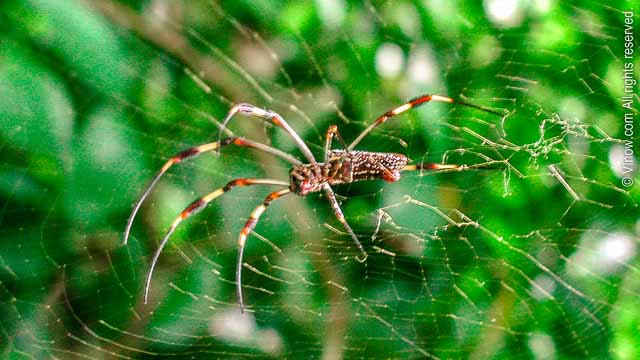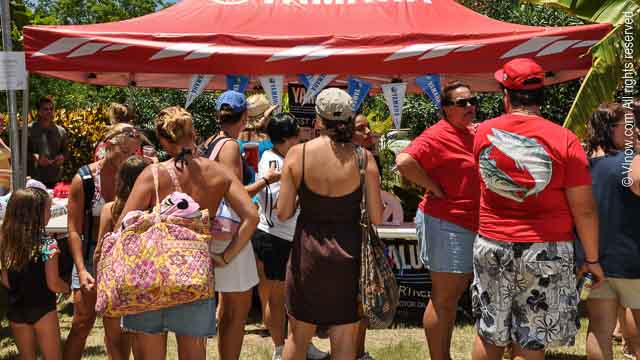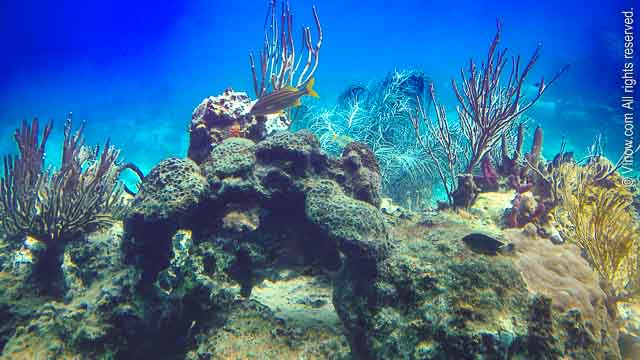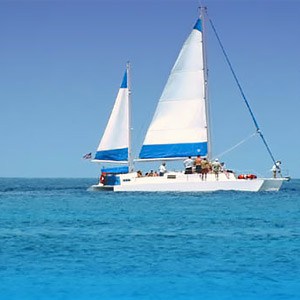When visitors think of water in the Virgin Islands the brackish water of wetlands isn’t likely anywhere in the lineup of mental images. More than likely those that come to mind include crystal clear beaches and the beautiful blue ocean. Wetlands however play an important role in keeping beaches clear and clean. In the Virgin Islands mangroves are one of the most common types of wetland systems.
Mangroves in the Virgin Islands – Unique Trees
Mangrove species thrive in salty conditions not tolerated by many other plants. They have evolved unique ways that allow them to survive in oxygen deprived, water logged soils. In the Virgin Islands there are three types of mangroves; Red, Black and White.
Red Mangroves: Masters of Waterlogged Soils
The Red Mangrove grows in the wettest environment of the three types, typically growing directly in water. They are able to survive by elevating themselves above the water on proproots. These proproots allow the plant to exchange oxygen and provides support for the plant. The roots are special in another way; they serve as a filtration system that prevents salt uptake into the plant.
Black Mangroves: Breathing Above the Water
Unlike the Red Mangroves, Black Mangroves cannot tolerate being constantly submerged. It grows in drier areas where flooding may occur only during high tides or storms. Black Mangroves breathe using snorkels! Pneumatophores are special roots that function like a snorkel allowing the plant to breathe. The Black Mangrove projects the roots above the soil surface or water level to allow oxygen exchange.
White Mangroves: Thriving Inland and Beyond
White Mangroves are usually found more inland in moist sandy areas of lower salinity. They prefer drier soil and more fresh water – areas such as coastal ponds with little connection to the sea. White Mangroves sometimes produce ‘snorkels’ like the Black Mangrove. Another trait they share with the Black Mangrove is the ability to excrete excess salt through special leaves. The White Mangrove has two small pores on the stem which it uses in addition to the leaf surface for ridding itself of salt.
Mangroves: Guardians of Coastal Ecosystems
Mangrove wetland systems protect coastal waters and the marine environment by collecting and filtering rain water runoff as well as capturing sediment from eroding soil which typically contains excess nutrients. By balancing the nutrient flow between land and sea, wetland systems protect near shore marine life, including coral reefs. Mangroves also protect coastlines from wave erosion.
Wildlife Havens: The Rich Biodiversity of Mangrove Forests
Mangroves are very important to wildlife and marine life. The forests they form create a sheltered ecosystem that provides breeding, rearing and feeding grounds for iguanas and birds. In fact, over 90% of the indigenous and migratory birds in the Virgin Islands depend on wetlands for feeding, nesting and roosting. Marine life benefit too; the long proproots of the Red Mangrove serve as a nursery area for many coral reef fish and invertebrates. The juvenile marine animals find protection among the long roots.
Mangrove Wetland Systems in the U.S. Virgin Islands
Here are some excellent examples of mangrove areas you can visit in the U.S. Virgin Islands. Other mangrove areas exist however those listed are protected areas that offer recreational and educational opportunities such as eco-tours, kayaking, bird watching, snorkeling and hiking.
St. Thomas

Located off the east end of St. Thomas the Mangrove Lagoon Marine Reserve and Wildlife Sanctuary is a complex series of small islets made up entirely of Red Mangroves. It is a protected area and home to birds such as the endangered brown pelican, blue herons, egrets, hummingbirds and others. Ecotour kayak trips are available for exploring the mangroves above the water. These trips often include snorkeling too which allows an opportunity to view the unique marine habitat the long proproots create for juvenile fish.
St. Croix

Located on the north shore of St. Croix the Salt River Bay National Historic Park and Ecological Preserve encompasses one of the largest remaining mangrove forests in the U.S. Virgin Islands. This is a fringing and basin forest. Among the variety of birds that might be seen some of the more common are brown bobby, brown pelican, frigate birds, herons, egrets, hummingbirds, pearly-eyed trasher and ground doves. The park contains federally and locally endangered flora and fauna. Kayaking trips are available to explore the lagoon and forest and SCUBA diving trips for exploring the underwater area, primarily canyons and coral reefs.
St. John

Mary’s Creek is home to a fringing mangrove forest that grows around the bay. The nearby Francis Bay Pond has mangroves growing around the pond. Visitors can appreciate the beautiful Mary’s Creek area and see some mangroves up close from the roadside by Leinster Bay. A hiking trail, Francis Bay Hiking Trail, begins at the west end of the Mary’s Creek road. The trail passes through a dry forest and leads to the mangrove forest and pond. Viewing areas along the trail allow an opportunity to bird watch.
Mangroves are Threatened, How you can Help
Wetland communities in the Virgin Islands, including mangroves, make up only around 2% of total plant communities. Their importance is recognized and they are legally protected. They continue however to be threatened by land development pressures and natural causes. Mangroves grow in protected bays, areas that are ideal for marinas and boat facilities. Over the past 50 years, 40 to 50% lost in mangroves has been attributed to these and other activities. Storms have caused problems too. Mangroves already surviving under stressful conditions generally do not recover from major storm damage that can strip all their leaves and damage their bark.
Your Role in Mangrove Conservation: Simple Steps to Make a Difference
When visiting mangrove areas help protect them; do not damage any part of the plant and try not to step on their special roots. The ‘snorkel’ roots used by the Black and White Mangroves to breathe are important to its survival. They are easily spotted sticking out from the sand and mud near the tree so easy to avoid. Also, do not remove their seeds. The Red Mangrove in particular has unique seeds; they resemble long pods and are called a propagule. They hang from the tree until mature and then drop; if the water is shallow it might stick and grow. If not, the propagule can drift many miles from the parent tree and find a new area to grow.






